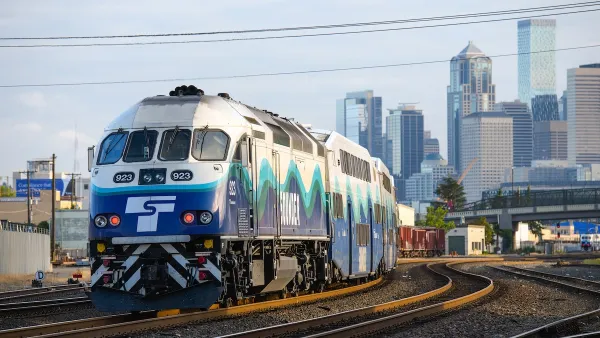Getting stuck in traffic is fast becoming one of those necessary evils that everyone complains about but seldom does anything about it. Or at least anything that seems terribly effective. Neither additional road building nor public transit seemed to have had a major impact on traffic congestion in places where these types of remedies have been attempted.
Getting stuck in traffic is fast becoming one of those necessary evils that everyone complains about but seldom does anything about it. Or at least anything that seems terribly effective. Neither additional road building nor public transit seemed to have had a major impact on traffic congestion in places where these types of remedies have been attempted.
But there's no lack of ideas on how to solve the problem of congestion. Congestion pricing has been held up by some planners and economists as the closest thing to a panacea for solving our traffic woes. In the view of advocates of congestion pricing, congestion is caused because travel on the most congested roads is too cheap-it's free. Without prices to tell drivers how much they should drive, they drive too much, or at least at the wrong times. With congestion pricing, drivers would have to pay tolls to drive at the most congested times, say rush hour, and in the most congested places, perhaps in the central business district or on heavily traveled highways. The tolls, if calibrated correctly, would discourage some drivers from driving on the most congested roads and at the most congested times. Voila! Congestion would be reduced considerably.
I'm not going to argue about the efficacy of congestion pricing for reducing traffic. As one would expect, when the price of something rises, consumption decreases. Studies have generally found that congestion pricing does reduce traffic. Congestion pricing, however, raises some serious equity issues. Problems severe enough that I suggest we not adopt congestion pricing unless they can be addressed.
Congestion pricing makes explicit the cost of driving on a heavily traveled roads and this is its' strength. Drivers are forced to take into consideration the cost they impose on others when they decide to drive, a cost that is easier to ignore when the roads are free. Congestion pricing is a regressive public charge, however, because the charges in no way take account of the driver's ability to pay. Congestion pricing might lead to a two tiered road network where with those with the means cruise about whenever and wherever they want, whereas the poor might be forced to take back roads or travel off peak.
But charging people on other transits modes is common and also regressive. Airlines and commuter rail lines typically charge higher price during peak travel times. Why should equity concerns be allowed to derail a strategy that could go along way toward reliving traffic congestion?
Well unlike airline travel, driving is a lot less discretionary for most folks. Most of us simply have to drive to get to work, to shop, etc. Congestion pricing would presumably push off the road those who don't have to be there. But what about those who have to drive on certain routes at certain times? Congestion pricing would be a real burden for poorer folks in these who lack flexibility in choosing their driving times and routes.
Congestion pricing also makes an incremental contribution to the effects of increasing wealth stratification of American society. For the past few decades income and wealth inequality have been increasing in America. In a society where relatively few resources like health care or access to good schools is allocated by the market, the trend of increasing wealth inequality is less troubling. But in the US we rely heavily on the market to allocate resources. Access to good neighborhoods, schools, and health care, for example, are increasingly tied to one's economic standing.
Congestion pricing would render everyday driving as one more part of life that is dependent upon one's economic standing. In a society where inequality is growing doing we really want to reinforce the impacts of this trend?

Planetizen Federal Action Tracker
A weekly monitor of how Trump’s orders and actions are impacting planners and planning in America.

Map: Where Senate Republicans Want to Sell Your Public Lands
For public land advocates, the Senate Republicans’ proposal to sell millions of acres of public land in the West is “the biggest fight of their careers.”

Restaurant Patios Were a Pandemic Win — Why Were They so Hard to Keep?
Social distancing requirements and changes in travel patterns prompted cities to pilot new uses for street and sidewalk space. Then it got complicated.

Platform Pilsner: Vancouver Transit Agency Releases... a Beer?
TransLink will receive a portion of every sale of the four-pack.

Toronto Weighs Cheaper Transit, Parking Hikes for Major Events
Special event rates would take effect during large festivals, sports games and concerts to ‘discourage driving, manage congestion and free up space for transit.”

Berlin to Consider Car-Free Zone Larger Than Manhattan
The area bound by the 22-mile Ringbahn would still allow 12 uses of a private automobile per year per person, and several other exemptions.
Urban Design for Planners 1: Software Tools
This six-course series explores essential urban design concepts using open source software and equips planners with the tools they need to participate fully in the urban design process.
Planning for Universal Design
Learn the tools for implementing Universal Design in planning regulations.
Heyer Gruel & Associates PA
JM Goldson LLC
Custer County Colorado
City of Camden Redevelopment Agency
City of Astoria
Transportation Research & Education Center (TREC) at Portland State University
Camden Redevelopment Agency
City of Claremont
Municipality of Princeton (NJ)




























